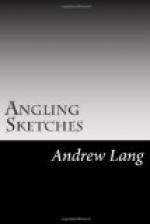Here, have I thought, ’twere
sweet to dwell,
And rear again the chaplain’s
cell.
But no longer does
“Your horse’s hoof tread
sound too rude,
So stilly is the solitude.”
Stilly! with the horns and songs from omnibusses that carry tourists, and with yells from nymphs and swains disporting themselves in the boats. Yarrow is only the old Yarrow in winter. Ages and revolutions must pass before the ancient peace returns; and only if the golden age is born again, and if we revive in it, shall we find St. Mary’s what St. Mary’s was lang syne—
Ah, Buddha, if thy tale be true,
Of still returning
life,
A monk may I be born anew,
In valleys free
from strife,—
A monk where Meggat winds and laves
The lone St. Mary’s of the
Waves.
Yarrow, which flows out of St. Mary’s Loch was never a great favourite of mine, as far as fishing goes. It had, and probably deserved, a great reputation, and some good trout are still taken in the upper waters, and there must be monsters in the deep black pools, the “dowie dens” above Bowhill. But I never had any luck there. The choicest stream of all was then, probably, the Aill, described by Sir Walter in “William of Deloraine’s Midnight Ride”—
Where Aill, from
mountains freed,
Down from the lakes did raving come;
Each wave was crested with tawny
foam,
Like the mane
of a chestnut steed.
As not uncommonly happens, Scott uses rather large language here. The steepy, grassy hillsides, the great green tablelands in a recess of which the Aill is born, can hardly be called “mountains.” The “lakes,” too, through which it passes, are much more like tarns, or rather, considering the flatness of their banks, like well-meaning ponds. But the Aill, near Sinton and Ashkirk, was a delightful trout-stream, between its willow-fringed banks, a brook about the size of the Lambourne. Nowhere on the Border were trout more numerous, better fed,




